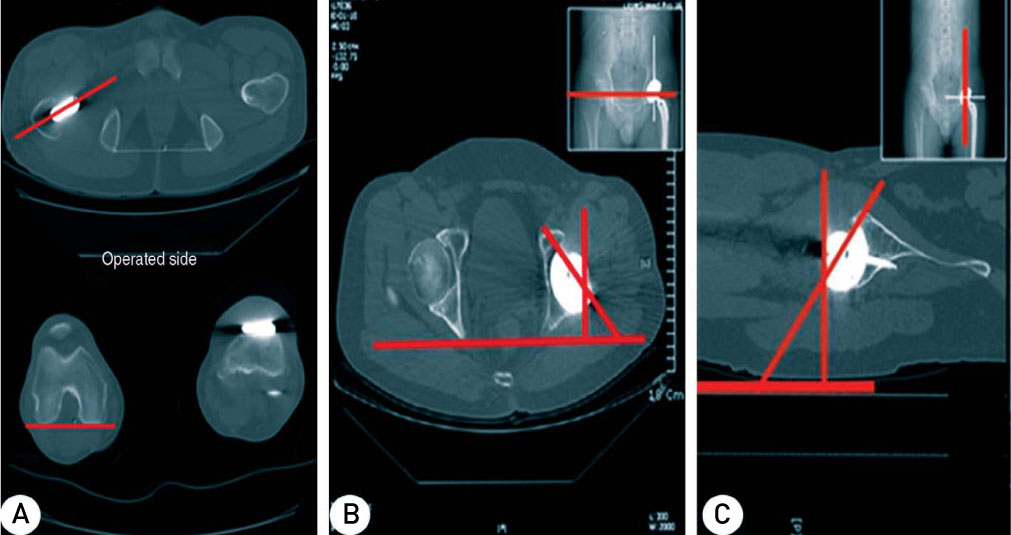Hip Pelvis.
2013 Mar;25(1):30-36. 10.5371/hp.2013.25.1.30.
Usefulness of a Modular Hip System for Combined Anteversion in Cementless Total Hip Arthroplasty
- Affiliations
-
- 1Department of Orthopedic Surgery, Konkuk University Medical Center, Seoul, Korea. damioh@gmail.com
- KMID: 1425033
- DOI: http://doi.org/10.5371/hp.2013.25.1.30
Abstract
- PURPOSE
The purpose of this study is to evaluate the usefulness of a modular total hip system for combined anteversion in cementless modular total hip arthroplasty.
MATERIALS AND METHODS
We performed twenty cementless modular total hip arthroplasty procedures. The patients lay in lateral position and 15degreesinternal rotation of the thigh. The surgeon inserted an acetabular cup component first, followed by a femoral component. He selected an appropriate modular neck component using an intra-operative manual combined anteversion test. All patients underwent post-operative computed tomography.
RESULTS
The average measurement of anteversion of the acetabular cup was 15.9+/-2.9degrees and anteversion of the femoral stem was 15.2+/-11.9degrees. Then, the combined anteversion was calculated to 24.0+/-8.2degrees. Significant difference was observed between combined anteversion and theoretical combined anteversion.
CONCLUSION
The method using an intra-operative manual combined anteversion test cannot realize the theoretical combined anteversion in cementless modular hip arthroplasty.
MeSH Terms
Figure
Cited by 1 articles
-
Primary Total Hip Arthroplasty Using Summit® Stems in Korean: Minimum Four-year Follow-up
Jae Sik Yoon, Joon Sun Kang, Kyoung Ho Moon
Hip Pelvis. 2017;29(4):228-233. doi: 10.5371/hp.2017.29.4.228.
Reference
-
1. Yoshimine F. The safe-zones for combined cup and neck anteversions that fulfill the essential range of motion and their optimum combination in total hip replacements. J Biomech. 2006. 39:1315–1323.
Article2. D'Lima DD, Urquhart AG, Buehler KO, Walker RH, Colwell CW Jr. The effect of the orientation of acetabular and femoral components on the range of motion of the hip at different head-neck ratios. J Bone Joint Surg Am. 2000. 82:315–321.3. Tannast M, Langlotz U, Siebenrock KA, Wiese M, Bernsmann K, Langlota F. Anatomic referencing of cup orientation in total hip arthroplasty. Clin Orthop Relat Res. 2005. (436):144–150.
Article4. Kummer FJ, Shah S, Iyer S, DiCesare PE. The effect of acetabular cup orientations on limiting hip rotation. J Arthroplasty. 1999. 14:509–513.
Article5. Kennedy JG, Rogers WB, Soffe KE, Sullivan RJ, Griffen DG, Sheehan LJ. Effect of acetabular component orientation on recurrent dislocation, pelvic osteolysis, polyethylene wear, and component migration. J Arthroplasty. 1998. 13:530–534.
Article6. Widmer KH, Zurfluh B. Compliant positioning of total hip components for optimal range of motion. J Orthop Res. 2004. 22:815–821.
Article7. Dorr LD, Malik A, Wan Z, Long WT, Harris M. Precision and bias of imageless computer navigation and surgeon estimates for acetabular component position. Clin Orthop Relat Res. 2007. 465:92–99.
Article8. Pierchon F, Pasquier G, Cotten A, Fontaine C, Clarisse J, Duquennoy A. Causes of dislocation of total hip arthroplasty. CT study of component alignament. J Bone Joint Surg Br. 1994. 76:45–48.9. Wines AP, McNicol D. Computed to.mography measurement of the accureacy of component version in total hip arthroplasty. J Arthroplasty. 2006. 21:696–701.
Article10. Dorr LD, Malik A, Dastane M, Wan Z. Combined anteversion technique for total hip arthroplasty. Clin Orthop Relat Res. 2009. 467:119–127.
Article11. Ranawat CS, Maynard MJ. Modern techniques of cemented total hip arthroplasty. Tech Orthop. 1991. 6:17–25.12. Murphy SB, Simon SR, Kijewski PK, Wilkinson RH, Griscom NT. Femoral anteversion. J Bone Joint Surg Am. 1987. 69:1169–1176.
Article13. Murray DW. The definition and measurement of acetabular orientation. J Bone Joint Surg Br. 1993. 75:228–232.
Article14. Del Schutte H Jr, Lipman AJ, Bannar SM, Livermore JT, Ilstrup D, Morrey BF. Effects of acetabular abduction on cup wear rates in total hip arthroplasty. J Arthroplasty. 1998. 13:621–626.
Article15. Yoder SA, Brand RA, Pedersen DR, O'Gorman TW. Total hip acetabular component position affects component loosening rates. Clin Orthop Relat Res. 1988. (228):79–87.
Article16. Lewinnek GE, Lewis JL, Tarr R, Compere CL, Zimmerman JR. Dislocations after total hip-replacement arthroplasties. J Bone Joint Surg Am. 1978. 60:217–220.
Article17. McCollum DE, Gray WJ. Dislocation after total hip arthroplasty. Causes and prevention. Clin Orthop Relat Res. 1990. (261):159–170.
Article18. Hisatome T, Doi H. Theoretically optimum position of the prosthesis in total hip arthroplasty to fulfill the severe range of motion criteria due to neck impingement. J Orthop Sci. 2011. 16:229–237.
Article
- Full Text Links
- Actions
-
Cited
- CITED
-
- Close
- Share
- Similar articles
-
- Reference Line Closer to the True Femoral Anteversion During Primary Cementless Total Hip Arthroplasty
- Implant Design in Cementless Hip Arthroplasty
- Modular Cementless Total Hip Arthroplasty with Subtrochanteric Shortening Osteotomy in Patients with High Hip Dislocation
- Total Hip Arthroplasty with F2L Multineck Cementless Femoral Stem
- Metal Debris Induced Osteolysis after Cementless Total Hip Arthroplasty: One case report



